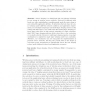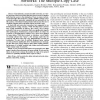545 search results - page 89 / 109 » Minimum energy accumulative routing in wireless networks |
GLOBECOM
2006
IEEE
14 years 2 months ago
2006
IEEE
– Clustering is a standard approach for achieving efficient and scalable performance in wireless sensor networks. Most of the published clustering algorithms strive to generate t...
ICCCN
2007
IEEE
14 years 3 months ago
2007
IEEE
Abstract— With the rapid deployment of wireless sensor networks, there are several new sensing applications with specific requirements. Specifically, target tracking applicatio...
EWSN
2009
Springer
14 years 9 months ago
2009
Springer
Sensor sleeping is a widely-used and cost-effective technique to save energy in wireless sensor networks. Protocols at different stack levels can, either individually or simultaneo...
TON
2008
13 years 8 months ago
2008
Abstract--Intermittently connected mobile networks are wireless networks where most of the time there does not exist a complete path from the source to the destination. There are m...
MOBISYS
2009
ACM
14 years 9 months ago
2009
ACM
Urban sensing, participatory sensing, and user activity recognition can provide rich contextual information for mobile applications such as social networking and location-based se...


